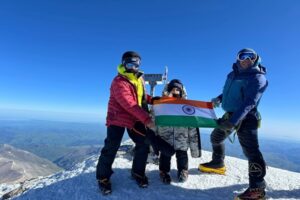Crowds will be less on Everest this year — that’s a good thing, for those going. And unlike 2020, at least the season will run.
Nepal’s weather office considers today, March 1, the official end of winter and the beginning of the pre-monsoon season, which goes until the end of May. Clear mornings and frequent evening storms, often accompanied by lightning, characterize the pre-monsoon.
After the economically ruinous pandemic year, the local tourism industry is hurrying to ready Sagarmatha National Park for the influx of foreigners. Many operators have already staked out the prime spots at Everest Base Camp. Yesterday, the Ice Doctors set off toward the treacherous Khumbu Icefall to set up the ascent route for this “year of returning”.

Ang Sharki leads the Icefall Doctors. Photo: The Himalayan Times
The 10-member team (plus two cooks), led by Ang Sarki Sherpa, will fix the route between Base Camp and Camp 2 on the Valley of Silence, up the normal route of Everest. It’s also the route for Lhotse and Nuptse climbs. The Icefall Doctors will then remain in Base Camp, keeping the way open and as safe as possible on the ever-moving glacier throughout the climbing season.
The Icefall Doctors are a team of highly skilled Sherpas deployed every year since 1997 — except for 2020 — by the Sagarmatha Pollution Control Committee (SPCC), under a contract with Nepal’s Ministry of Tourism. Each member of an expedition team has to pay $600 for using the route in spring. The rarer autumn expeditions must pay $25,000 to have that section of the route in shape.
Lively but not crowded
China has given no sign of opening its side of the mountain, so nearly all expeditions will run from the Nepal side. Still, overall numbers are expected to reach at most 60 percent of previous years, partly because many Western countries still face severe internal restrictions. The UK, for example, remains under a lockdown which won’t allow international travel till May 17 at the earliest — too late for spring Everest. As someone tweeted earlier today, “Everest may not be a holiday, but mountaineering is not given as a “legally permitted reason” to travel from the UK.”
The number of trekkers is particularly low compared to normal. Those involved partly blame Nepalese authorities for their delay in establishing new COVID protocols. These still aren’t tied down. In the meantime, foreigners arriving in Nepal follow the rules established last autumn, which include a negative PCR test taken just before flying, five days of quarantine, and a second negative PCR test before moving freely to the mountains. Those who work in tourism are particularly keen to eliminate or reduce the period of quarantine.
Some expedition leaders and international operators are already in Nepal, to sort out their paperwork as early as possible and to more quickly alert their clients of any pending change in the regulations.





